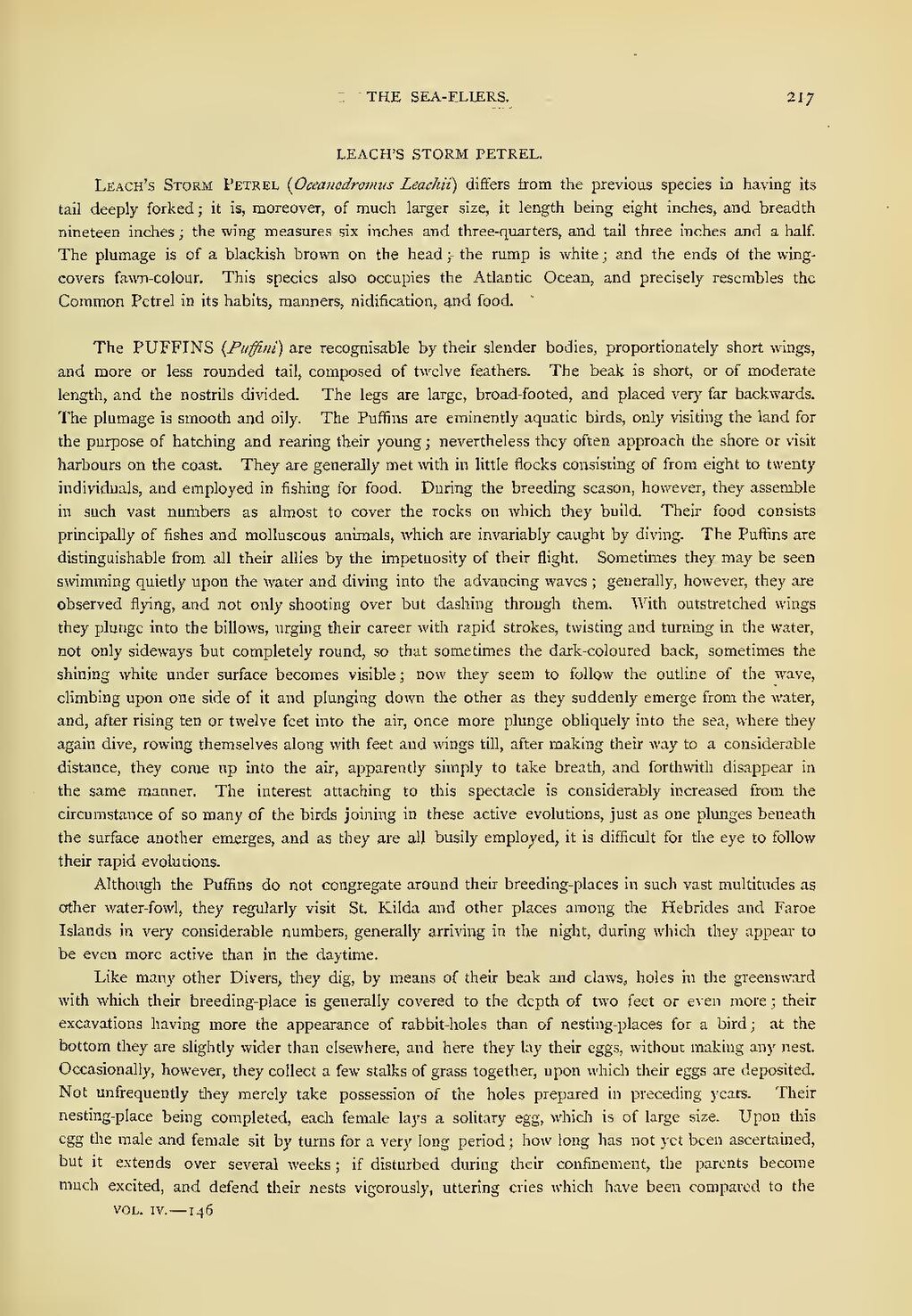LEACH'S STORM PETREL.
Leach's Storm Petrel (Oceanodromus Leachii) differs from the previous species in having its tail deeply forked; it is, moreover, of much larger size, it length being eight inches, and breadth nineteen inches; the wing measures six inches and three-quarters, and tail three inches and a half. The plumage is of a blackish brown on the head; the rump is white; and the ends of the wing-covers fawn-colour. This species also occupies the Atlantic Ocean, and precisely resembles the Common Petrel in its habits, manners, nidification, and food.
The PUFFINS (Puffini) are recognisable by their slender bodies, proportionately short wings, and more or less rounded tail, composed of twelve feathers. The beak is short, or of moderate length, and the nostrils divided. The legs are large, broad-footed, and placed very far backwards. The plumage is smooth and oily. The Puffins are eminently aquatic birds, only visiting the land for the purpose of hatching and rearing their young; nevertheless they often approach the shore or visit harbours on the coast. They are generally met with in little flocks consisting of from eight to twenty individuals, and employed in fishing for food. During the breeding season, however, they assemble in such vast numbers as almost to cover the rocks on which they build. Their food consists principally of fishes and molluscous animals, which are invariably caught by diving. The Puffins are distinguishable from all their allies by the impetuosity of their flight. Sometimes they may be seen swimming quietly upon the water and diving into the advancing waves; generally, however, they are observed flying, and not only shooting over but dashing through them. With outstretched wings they plunge into the billows, urging their career with rapid strokes, twisting and turning in the water, not only sideways but completely round, so that sometimes the dark-coloured back, sometimes the shining white under surface becomes visible; now they seem to follow the outline of the wave, climbing upon one side of it and plunging down the other as they suddenly emerge from the water, and, after rising ten or twelve feet into the air, once more plunge obliquely into the sea, where they again dive, rowing themselves along with feet and wings till, after making their way to a considerable distance, they come up into the air, apparently simply to take breath, and forthwith disappear in the same manner. The interest attaching to this spectacle is considerably increased from the circumstance of so many of the birds joining in these active evolutions, just as one plunges beneath the surface another emerges, and as they are all busily employed, it is difficult for the eye to follow their rapid evolutions.
Although the Puffins do not congregate around their breeding-places in such vast multitudes as other water-fowl, they regularly visit St. Kilda and other places among the Hebrides and Faroe Islands in very considerable numbers, generally arriving in the night, during which they appear to be even more active than in the daytime.
Like many other Divers, they dig, by means of their beak and claws, holes in the greensward with which their breeding-place is generally covered to the depth of two feet or even more; their excavations having more the appearance of rabbit-holes than of nesting-places for a bird; at the bottom they are slightly wider than elsewhere, and here they lay their eggs, without making any nest. Occasionally, however, they collect a few stalks of grass together, upon which their eggs are deposited. Not unfrequently they merely take possession of the holes prepared in preceding years. Their nesting-place being completed, each female lays a solitary egg, which is of large size. Upon this egg the male and female sit by turns for a very long period; how long has not yet been ascertained, but it extends over several weeks; if disturbed during their confinement, the parents become much excited, and defend their nests vigorously, uttering cries which have been compared to the
